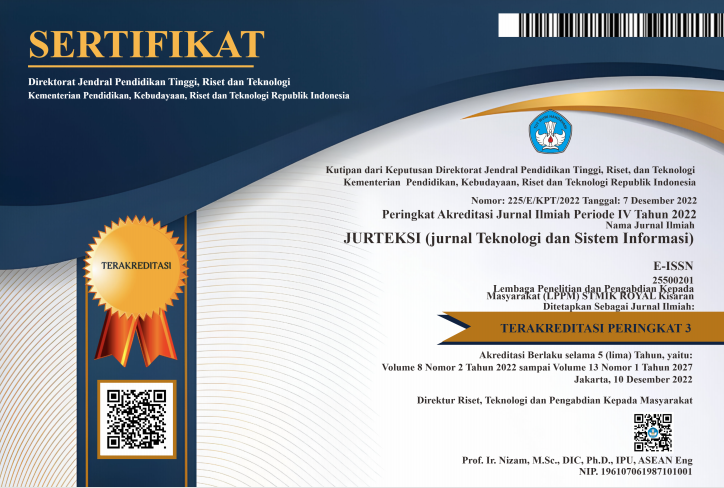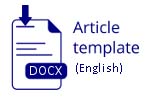USABILITY ANALYSIS OF WEB-BASED ANIMAL ADOPTION SYSTEM TO INCREASE USER EXPERIENCE
Abstract
Abstract: Usability testing of online animal adoption systems is important because it is not only related to the comfort and safety of users, but also to the welfare of the adopted animals. So far, usability testing of the animal adoption system on Eidos has not been carried out and there is a problem that there is confusion with the process flow in this animal adoption system. This usability testing uses the Heuristic Evaluation method and the System Usability Scale (SUS), which involves in-depth interviews to obtain results that are not only statistical assessments, but also deeper insights from the user's perspective. The results of the evaluation using Heuristic Evaluation obtained 59 problems, with an average severity rating of 3 or major, whose improvements have resulted in several draft design recommendations. The recommendation design has gone through final testing using the System Usability Scale (SUS) which managed to achieve a score of 78, or categorized as good, along with some minor critical feedback for system improvement. Therefore, users as a whole feel very satisfied in using the online adoption system from the results of the existing recommendation design. The implications of the resulting recommendation design have been tested for usability by three UI/UX design experts and users directly so that they can be used as a basis for developing a better online animal adoption system.
Keywords: animal adoption system; heuristic; prototype; system usability scale; usability
Abstrak: Pengujian usability sistem adopsi hewan secara online penting untuk diperhatikan karena tidak hanya berkaitan dengan kenyamanan dan keamanan penggunanya saja, tetapi juga meningkatkan kesejahteraan hewan yang diadopsi. Sejauh ini, pengujian usability dari sistem adopsi hewan pada Eidos masih belum dilakukan dan ditemukannya masalah bahwa adanya kebingungan dengan alur proses dalam sistem adopsi hewan ini. Pengujian usability ini menggunakan metode Heuristic Evaluation dan System Usability Scale (SUS), yang melibatkan in-depth interview untuk memperoleh hasil yang bukan hanya berupa penilaian statistik saja, melainkan juga wawasan yang lebih mendalam dari sudut pandang pengguna. Hasil evaluasi menggunakan Heuristic Evaluation mendapatkan 59 permasalahan, dengan rata-rata perhitungan severity rating sebesar tiga atau major, yang perbaikannya telah menghasilkan beberapa rancangan desain rekomendasi. Adapun desain rekomendasi tersebut telah melalui pengujian akhir menggunakan System Usability Scale (SUS) yang berhasil meraih skor sebesar 78, atau terkategori good, disertai beberapa umpan balik kritis yang bersifat minor untuk peningkatan sistem. Dengan demikian, pengguna secara keseluruhan merasa sangat puas dalam menggunakan sistem adopsi online dari hasil desain rekomendasi yang ada. Implikasi desain rekomendasi yang dihasilkan telah teruji kegunaannya oleh sebanyak tiga ahli UI/UX design dan pengguna secara langsung sehingga dapat digunakan sebagai landasan bagi pengembangan sistem adopsi hewan secara online yang lebih baik.
Kata kunci: heuristik; kebergunaan; prototipe; sistem adopsi hewan; system usability scale
References
A. Cindy Mutia, “Indonesia Paling Banyak Unggah Video Penyiksaan Hewan,†Databoks, 2021. https://databoks.katadata.co.id/datapublish/2021/09/24/indonesia-paling-banyak-unggah-video-penyiksaan-hewan (accessed Dec. 14, 2023).
T. Y. Yan and K. T. yun Teng, “Trends in Animal Shelter Management, Adoption, and Animal Death in Taiwan from 2012 to 2020,†Animals, vol. 13, no. 9, pp. 1–17, 2023, doi: 10.3390/ani13091451.
B. S. Campanilla, J. O. Etcuban, A. P. Maghanoy, A. P. Nacua, and N. S. Galamiton, “Pet Adoption App To Free Animal Shelters,†J. Posit. Sch. Psychol., vol. 6, no. 8, pp. 5993–6006, 2022, [Online]. Available: http://journalppw.com.
V. Vinessa and S. Kusniadji, “Proses Komunikasi Melalui Kegiatan Event Adopt Don’t Shop Guna Mengkampanyekan Kesadaran Masyarakat agar Menyayangi Binatang,†Prologia, vol. 2, no. 2, p. 538, 2019, doi: 10.24912/pr.v2i2.3742.
A. Prehanto, R. Gelar, and N. Masum, “Pemanfaatan Webinar Sebagai Alternatif Digitalisasi Informasi dalam Seminar Kurikulum,†Indones. J. Digit. Bus., vol. 1, no. 1, pp. 43–49, 2021, doi: 10.17509/ijdb.v1i1.34356.
D. J. Kartika, H. Tolle, and R. K. Dewi, “Perancangan User Experience menggunakan pendekatan Human-Centered Design untuk Aplikasi Adopsi Hewan,†vol. 5, no. 10, pp. 4241–4250, 2021.
I. Salamah, “Evaluasi Usability Website Polsri Dengan Menggunakan System Usability Scale,†vol. 8, pp. 176–183, 2019.
I. 9241-11, “Ergonomics of human-system interaction — Part 11: Usability: Definitions and concepts,†2018. https://www.iso.org/obp/ui/en/#iso:std:iso:9241:-11:ed-2:v1:en.
Guntoro, Lisnawita, and L. Costaner, “Exploring Research and Service Information System Usability by Heuristic Evaluation as a Compelement of System Usability Scale,†J. Penelit. Pendidik. IPA, vol. 9, no. 12, pp. 11045–11052, 2023, doi: 10.29303/jppipa.v9i12.5571.
A. Pascagama Nurrachman and Y. Priyandari, “Pengujian Usability pada Aplikasi Informasi Akademik Mahasiswa Universitas Diponegoro berbasis Android Usability Testing of Academic Information Application for Universitas Diponegoro Students based on Android,†Agustus, vol. 21, no. 3, pp. 534–542, 2022, [Online]. Available: https://bit.ly/UsabilityTestSiapUndip.
S. P. Nur Aini and S. N. Khasanah, “Analysis of Usability Using Heuristic Evaluation Method and Measurement of Sus on Pricilia Application,†J. Techno Nusa Mandiri, vol. 20, no. 2, pp. 71–79, 2023, doi: 10.33480/techno.v20i2.4582.
S. P. Budiarto and D. Y. R.L, “Evaluasi Usability pada Aplikasi Jemput Sampah Online Desa Rejosari Menggunakan Metode System Usability Scale (SUS),†J. Eksplora Inform., vol. 13, no. 1, pp. 100–112, 2023, doi: 10.30864/eksplora.v13i1.822.
Findra Kartika Sari Dewi, Thomas Adi Purnomo Sidhi, and Y. C. Darmawan, “Analisis Usability Web SIATMA dengan Metode Heuristic Evaluation dan System Usability Scale,†J. Buana Inform., vol. 14, no. 02, pp. 87–96, 2023, doi: 10.24002/jbi.v14i02.5027.
J. Nielsen and R. Molich, “Heuristic evaluation of user interfaces,†Conf. Hum. Factors Comput. Syst. - Proc., no. April, pp. 249–256, 1990, doi: 10.1145/97243.97281.
U. Ependi, T. B. Kurniawan, and F. Panjaitan, “System Usability Scale Vs Heuristic Evaluation: a Review,†Simetris J. Tek. Mesin, Elektro dan Ilmu Komput., vol. 10, no. 1, pp. 65–74, 2019, doi: 10.24176/simet.v10i1.2725.
J. Nielsen, “Ten usability heuristics,†2005.
J. Nielsen, “Severity Ratings for Usability Problems,†1994. https://www.nngroup.com/articles/how-to-rate-the-severity-of-usability-problems/ (accessed Dec. 17, 2023).
R. Alroobaea and P. J. Mayhew, “How many participants are really enough for usability studies?,†Proc. 2014 Sci. Inf. Conf. SAI 2014, no. October, pp. 48–56, 2014, doi: 10.1109/SAI.2014.6918171.
J. Brooke, “Sus: a “quick and dirty’usability,†Usability Eval. Ind., vol. 189, no. 3, pp. 189–194, 1996.
J. Sauro, A practical guide to the system usability scale: Background, benchmarks & best practices. Measuring Usability LLC, 2011.













